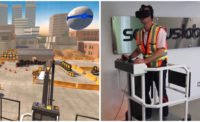
Technology First Read
Addressing Safety And the Skilled Labor Shortage Through Virtual Reality
A properly designed VR training program can scale up your workforce with labor at a premium

This solar project in Wisconsin has construction activities on it that virtual training can assist to rapidly skill up its workforce. Photo Courtesy of Wood County Solar

As the year comes to an end, the construction industry’s ongoing skilled labor shortage continues to be top-of-mind for many contractors, with an ongoing need for qualified, skilled craft professionals. In just the last year, the industry faced a significant shortage of more than half a million workers (according to Associated Builders and Contractors) with an estimated 1.2 million construction workers planning to leave their jobs to work in other industries.
In an effort to tackle this industry-wide challenge, Mortenson has developed an innovative, new Virtual Reality (VR) Quality Training Program that not only helps to enhance safety, quality and efficiency on the job site by leveraging new technology in virtual reality trainings—but also helps to better prepare new field employees for the on-site challenges they may face from day-to-day.
Multi-User VR Quality Training
An example of this critical work involves Mortenson’s Wind Energy Group. We have designed a multi-user VR Quality Training Program with 50 phases, drawings and tools that allows new field engineers to virtually move forward and backward in time to help users understand the scale, thoroughness and level of detail required to successfully service wind turbines and understand how to complete complex jobs before ever stepping foot on-site.
Implemented by Mortenson’s Quality Director and Quality Managers, the program has successfully trained engineers in various settings and locations for the past year—helping them prepare for their jobs before they are ever come under the pressure of accomplishing complex tasks quickly and correctly.
Virtual Reality Training: Challenges & Opportunities
What are the key elements, opportunities and challenges surrounding a successful VR training program? While still very much in its infancy, construction companies across sectors have a great opportunity to engage employees in this type of training to make builders better builders—and thus better companies.
To begin, timelines for creating these programs depend upon the complexity of the tasks and training. With our Wind Energy Construction & Development Group training, we spent many months developing foundational tools such as the code to allow us to co-locate several people in the same training environment, and for the training components to be advanced through time. Once that was done, it became possible to focus more on the creation of the models and drawings specific to each training environment. This can usually be done in a couple of weeks.
While trying to home-in on the key elements for a program, it’s also incredibly important to capitalize on the strengths of the VR training. Ask yourself “what does this training do that we can’t do via any other medium?” VR excels at providing a realistic sense of scale and perspective, which can be very impactful. We’ve used this so far to help our employees understand how big the scale of the assemblies they need to inspect are, and how they will need to be prepared for those tasks.
Another great thing about VR training is its portability. Many of the tasks we need to train on are best done on the actual object. The pre-pour inspection of a complex shear wall, as many of you know, only exists for a brief period of time before it’s covered up. Creating shear wall inspection training allows us to train on a simulation of the actual object wherever and whenever we need to, at a more deliberate and methodical speed than would otherwise be possible.
While the key elements are common and opportunities broad, there are logistical challenges surrounding the deployment of a VR quality training program. Many are unfamiliar with virtual reality headsets and need to be trained on how to use them. Additionally, they aren’t always easily accessible — when someone new wants to use the training, we may need to either ship or buy. To help the industry start using VR more ubiquitously, there is a lot more background work that needs to be done by the headset manufacturers to make the devices truly workplace friendly. Much of this work is currently underway, which is encouraging.
Moving Forward with a Nascent Technology
While VR quality training is a nascent technology that we’re still figuring out how to best deploy, it has momentum and the potential to benefit the entire industry—not only for improving quality and helping train new employees, but also for ensuring workforce safety by increasing the likelihood that jobs are completed correctly.
At Mortenson, we’ve started working on other new training programs for our solar group and are in-progress on a training for the erection process on one of the largest wind turbines available, the Vestas V162. We’re excited about the potential of this type of training and are looking forward to seeing how other industry players start to deploy it.
As an Emerging Technologies Developer with Mortenson, Will Adams explores how the intersections of architecture, programming and novel technology can positively impact the rapidly-changing building industry. Will works with customers to help them understand the possibilities of what Mortenson can do for them, create compelling visions, and ultimately bring those visions to fruition through meaningful results. For more information, visit www.mortenson.com or contact Will at will.adams@mortenson.com



